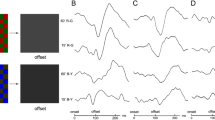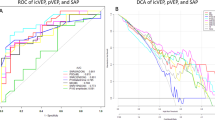Abstract
Dysthyroid optic neuropathy is the most serious, although infrequent (8–10 %) complication in Graves’ orbitopathy (GO). It is known that early stages of compressive optic neuropathy may produce reversible visual field defects, suggesting axoplasmic stasis rather than ganglion cell death. This observational, cross-sectional, case–control study assessed 34 consecutive patients (65 eyes) with Graves’ hyperthyroidism and longstanding GO and 31 age-matched control subjects. The patients’ multifocal visual evoked potentials (mfVEP) were compared to their clinical and psychophysical (standard automated perimetry [SAP]) and structural (optic coherence tomography [OCT]) diagnostic test data. Abnormal cluster defects were found in 12.3 % and 3.1 % of eyes on the interocular and monocular amplitude analysis mfVEP probability plots, respectively. As well, mfVEP latencies delays were found in 13.8 and 20 % of eyes on the interocular and monocular analysis probability plots, respectively. Interestingly, 19 % of patients with GO had ocular hypertension, and a strong correlation between intraocular pressure measured at upgaze and mfVEP latency was found. MfVEP amplitudes and visual acuity were significantly related to each other (P < 0.05), but not with the latencies delays. However, relationships between the interocular or monocular mfVEP amplitudes and latencies analysis and SAP indices or OCT data were not statistically significant. One-third of our patients with GO showed changes in the mfVEP, indicating significant subclinical optic nerve dysfunction. In this sense, the mfVEP may be a useful diagnostic tool in the clinic for early diagnosis and monitoring of optic nerve function abnormalities in patients with GO.



Similar content being viewed by others
References
Ebner R (2002) Dysthyroid optic neuropathy (DON). Semin Ophthalmol 17:18–21
Trobe JD (1981) Optic nerve involvement in dysthyroidism. Ophthalmology 88:488–492
Boulos PR, Hardy I (2004) Thyroid-associated orbitopathy: a clinicopathological and therapeutic review. Curr Opin Ophthalmol 15:389–400
Neigel JM, Rootman J, Belkin RI, Nugent RA, Drance SM, Beattie CW, Spinelli JA (1988) Dysthyroid optic neuropathy. The crowded orbital apex syndrome. Ophthalmology 95:1515–1521
Perry JD, Kadakia A, Foster JA (2003) Transcaruncular orbital decompression for dysthyroid optic neuropathy. Ophthal Plast Reconstr Surg 19:353–358
McKeag D, Lane C, Lazarus JH, Baldeschi L, Boboridis K, Dickinson AJ, Hullo AI, Kahaly G, Krassas G, Marcocci C, Marinò M, Mourits MP, Nardi M, Neoh C, Orgiazzi J, Perros P, Pinchera A, Pitz S, Prummel MF, Sartini MS, Wiersinga WM, European Group on Graves’ Orbitopathy (EUGOGO) (2007) Clinical features of dysthyroid optic neuropathy: a European Group on Graves’ Orbitopathy (EUGOGO) survey. Br J Ophthalmol 91:455–458
Labonia AF, Carnovale-Scalzo G, Paola A, De’ Morelli G, Scorcia V, Bruzzichessi D, Scorcia G, Costante G (2008) Subclinical visual field alterations are commonly present in patients with Graves’ Orbitopathy and are mainly related to the clinical activity of the disease. Exp Clin Endocrinol Diabetes 116:347–351
Dickinson AJ, Perros P (2001) Controversies in the clinical evaluation of active thyroid-associated orbitopathy: use of a detailed protocol with comparative photographs for objective assessment. Clin Endocrinol (Oxf) 55:283–303
Cockerham KP, Pal C, Jani B, Wolter A, Kennerdell JS (1997) The prevalence and implications of ocular hypertension and glaucoma in thyroid-associated orbitopathy. Ophthalmology 104:914–917
Ohtsuka K (1997) Intraocular pressure and proptosis in 95 patients with Graves ophthalmopathy. Am J Ophthalmol 124:570–572
Danesh-Meyer HV, Carroll SC, Foroozan R, Savino PJ, Fan J, Jiang Y, Vander Hoorn S (2006) Relationship between retinal nerve fiber layer and visual field sensitivity as measured by optical coherence tomography in chiasmal compression. Invest Ophthalmol Vis Sci 47:4827–4835
Hood DC, Odel JG, Zhang X (2000) Tracking the recovery of local optic nerve function after optic neuritis: a multifocal VEP study. Invest Ophthalmol Vis Sci 41:4032–4038
Hood DC, Odel JG, Winn BJ (2003) The multifocal visual evoked potential. J Neuroophthalmol 23:279–289
Ambrosio G, Ferrara G, Vitale R, De Marco R (2003) Visual evoked potentials in patients with Graves’ ophthalmopathy complicated by ocular hypertension and suspect glaucoma or dysthyroid optic neuropathy. Doc Ophthalmol 106:99–104
Rutecka-Dębniak A, Lubiński W, Krzystolik Z (1999) Visual evoked potentials in diagnosis and monitoring of optic neuropathy in the course of thyroid ophthalmopathy. Klin Oczna 101:361–365
Pawłowski P, Myśliwiec J, Mrugacz M, Bakunowicz-Łazarczyk A, Górska M (2006) Pattern visual evoked potentials in the early diagnosis of optic neuropathy in the course of Graves’ ophthalmopathy. Endokrynol Pol 57:122–126
Mourits MP, Prummel MF, Wiersinga WM, Koornneef L (1997) Clinical activity score as a guide in the management of patients with Graves’ ophthalmopathy. Clin Endocrinol (Oxf) 47:9–14
Prummel MF, Bakker A, Wiersinga WM, Baldeschi L, Mourits MP, Kendall-Taylor P, Perros P, Neoh C, Dickinson AJ, Lazarus JH, Lane CM, Heufelder AE, Kahaly GJ, Pitz S, Orgiazzi J, Hullo A, Pinchera A, Marcocci C, Sartini MS, Rocchi R, Nardi M, Krassas GE, Halkias A (2003) Multi-center study on the characteristics and treatment strategies of patients with Graves’ orbitopathy: the first European Group on Graves’ Orbitopathy experience. Eur J Endocrinol 148:491–495
Baseler HA, Sutter EE, Klein SA, Carney T (1994) The topography of visual evoked response properties across the visual field. Electroencephalogr Clin Neurophysiol 90:65–68
Sutter EE (2001) Imaging visual function with the multifocal m-sequence technique. Vision Res 41:1241–1255
Hood DC, Zhang X, Hong JE, Chen CS (2002) Quantifying the benefits of additional channels of multifocal VEP recording. Doc Ophthalmol 104:303–320
Hood DC, Greenstein VC (2003) Multifocal VEP and ganglion cell damage: applications and limitations for the study of glaucoma. Prog Retin Eye Res 22:201–251
Hood DC, Greenstein VC, Odel JG, Zhang X, Ritch R, Liebmann JM, Hong JE, Chen CS, Thienprasiddhi P (2002) Visual field defects and multifocal visual evoked potentials: evidence of a linear relationship. Arch Ophthalmol 120:1672–1681
Fortune B, Zhang X, Hood DC, Demirel S, Johnson CA (2004) Normative ranges and specificity of the multifocal VEP. Doc Ophthalmol 109:87–100
Hood DC, Zhang X, Rodarte C, Yang EB, Ohri N, Fortune B, Johnson CA (2004) Determining abnormal interocular latencies of multifocal visual evoked potentials. Doc Ophthalmol 109:177–187
Goldberg I, Graham SL, Klistorner I (2002) Multifocal objective perimetry in the detection of glaucomatous field loss. Am J Ophthalmol 133:29–39
Laron M, Cheng H, Zhang B, Schiffman JS, Tang RA, Frishman LJ (2010) Comparison of multifocal visual evoked potential, standard automated perimetry and optical coherence tomography in assessing visual pathway in multiple sclerosis patients. Mult Scler 16:412–426
Danesh-Meyer HV, Carroll SC, Gaskin BJ, Gao A, Gamble GD (2006) Correlation of the multifocal visual evoked potential and standard automated perimetry in compressive optic neuropathies. Invest Ophthalmol Vis Sci 47:1458–1463
Abbott RJ, O’Malley BP, Barnett DB, Timson L, Rosenthal FD (1983) Central and peripheral nerve conduction in thyroid dysfunction: the influence of l-thyroxine therapy compared with warming upon the conduction abnormalities of primary hypothyroidism. Clin Sci 64:617–622
Ladenson PW, Stakes JW, Ridgway EC (1984) Reversible alteration of the visual evoked potential in hypothyroidism. Am J Med 77:1010–1013
Osterweil D, Syndulko K, Cohen SN, Pettler-Jennings PD, Hershman JM, Cummings JL, Tourtellotte WW, Solomon DH (1992) Cognitive function in non-demented older adults with hypothyroidism. J Am Geriatr Soc 40:325–335
Semela L, Yang EB, Hedges TR, Vuong L, Odel JG, Hood DC (2007) Multifocal visual-evoked potential in unilateral compressive optic neuropathy. Br J Ophthalmol 91:445–448
Rodarte C, Hood DC, Yang EB, Grippo T, Greenstein VC, Liebmann JM, Ritch R (2006) The effects of glaucoma on the latency of the multifocal visual evoked potential. Br J Ophthalmol 90:1132–1136
Hinson SR, Pittock SJ, Lucchinetti CF, Roemer SF, Fryer JP, Kryzer TJ, Lennon VA (2007) Pathogenic potential of IgG binding to water channel extracellular domain in neuromyelitis optica. Neurology 69:2221–2231
Acaroğlu G, Simşek T, Ozalp S, Mutluay A (2003) Subclinical optic neuropathy in Graves’ orbitopathy. Jpn J Ophthalmol 47:459–462
Spadea L, Bianco G, Dragani T, Balestrazzi E (1997) Early detection of P-VEP and PERG changes in ophthalmic Graves’ disease. Graefes Arch Clin Exp Ophthalmol 235:501–505
Salvi M, Spaggiari E, Neri F, Macaluso C, Gardini E, Ferrozzi F, Minelli R, Wall JR, Roti E (1997) The study of visual evoked potentials in patients with thyroid-associated ophthalmopathy identifies asymptomatic optic nerve involvement. J Clin Endocrinol Metab 82:1027–1030
Chen CS, Hood DC, Zhang X, Karam EZ, Liebmann JM, Ritch R, Thienprasiddhi P, Greenstein VC (2003) Repeat reliability of the multifocal visual evoked potential in normal and glaucomatous eyes. J Glaucoma 12:399–408
Ben Ayed H, Hamedani M, Bok C, Barraco P, Oubaaz A, Morax S (2002) Intraocular high pressure in thyroid-associated orbitopathy: physiopathological mechanisms, diagnosis, and management. J Fr Ophtalmol 25:15–22
Acknowledgments
This study was supported by Fundación Lain Entralgo and FISCAM PI-2008/09.
Conflict of interest
None.
Author information
Authors and Affiliations
Corresponding author
Rights and permissions
About this article
Cite this article
Pérez-Rico, C., Rodríguez-González, N., Arévalo-Serrano, J. et al. Evaluation of multifocal visual evoked potentials in patients with Graves’ orbitopathy and subclinical optic nerve involvement. Doc Ophthalmol 125, 11–19 (2012). https://doi.org/10.1007/s10633-012-9325-2
Received:
Accepted:
Published:
Issue Date:
DOI: https://doi.org/10.1007/s10633-012-9325-2




